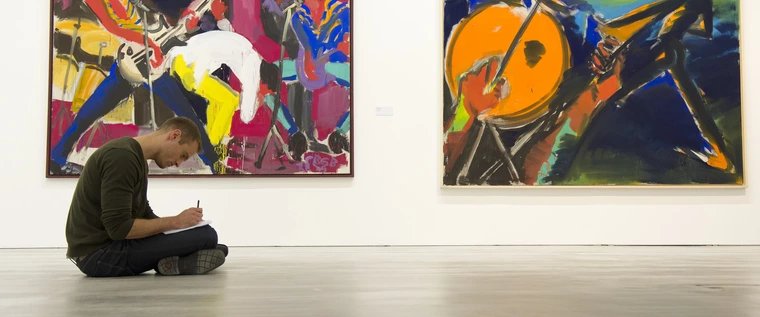
Collection presentation
The presentation from our collection is a multi-facetted tour through the art of Berlin from 1880 to 1980. It ranges from paintings of the late 19th century, when the Kaiser reigned and tastes were largely determined by the moneyed classes, via Expressionism and the East European avant-garde to post-war modern architecture and the “wild” works of the Seventies.
Reflecting the interdisciplinary nature of the collection, there is a lively dialogue between paintings, prints, sculpture, photography and architecture. The show illustrates a diversity of artistic styles and credos, but also tensions, polarisations and fresh departures, which remain hallmarks of Berlin as an artistic hub. As a city of the modern age that is attracting more young international artists than ever before, Berlin is still a centre of permanent new beginnings.
Fine Arts
In the Fine Arts, there are paintings and sculptures by great artists such as Max Liebermann, Max Beckmann, Otto Dix, Naum Gabo and Wolf Vostell. There is also a chance to discover works by lesser-known protagonists of Impressionism, Expressionism, the East European avant-garde, New Objectivity, Art Informel and the figurative art of the 1960s and 1970s. We make a special effort to recall those artists who had slipped into oblivion as a result of the two World Wars and, in particular, the repression suffered by art and artists during the Nazi regime, such as Felix Nussbaum, Hannah Höch and Werner Heldt.
The Berlinische Galerie boasts one of Germany’s major collections of artistic Photography, reflecting the significant role Berlin played in the medium’s history from about 1900 until 1980.
On display at the moment are early street photographs from around 1900 (Heinrich Zille), modernist works from the 1920s (Steffi Brandl, Fritz Brill), photojournalism of the same period (Erich Salomon, Felix H. Man), Nazi propaganda images from the magazine “Volk und Welt”, pictures of the aftermath of World War II (Yevgeni Khaldei and Ivan Mikhailovitch Shagin), “subjective photography” from the 1950s (Fritz Kühn) and the young movement of Autorenfotografie in the 1970s (Gabriele and Helmut Nothhelfer).
Prints and Drawings
Highlights in the collection of Prints and Drawings include a considerable volume of output from Dada (Hannah Höch and others), New Objectivity (Jeanne Mammen, Gertrude Sandmann) and the post-war period from 1945 (Hans Uhlmann, Werner Heldt). While works by Hannah Höch can currently be admired in the special exhibition “Dada Africa”, and a major show on Jeanne Mammen is planned for 2017, others such as Gertrude Sandmann and Hans Uhlmann convey a sense of the difficult years between 1933 and 1945, and the drawings by Werner Heldt are tinged with the melancholy of reconstruction after 1945. Architecture Apart from the model of the Star Church (designed in 1921/1922 by Otto Bartning) and the films and photographs recording projects of the 1930s (Hermann Kaspar, Albert Speer), the Architecture collection offers plans, sketches, photographs and models to illustrate important schemes and buildings in Berlin during the period known as post-war modernism (1950s to early 1970s).
Artists’ Archives
The Artists’ Archives, full of catalogues, magazines, historical photographs and sales records, trace early approaches to publicising modern art. Beginning with the pioneering exhibitions of the Berlin Secession, the pathway leads to the revolutionary ethos of the Weimar Republic. Innovative strategies such as postcards created by artists, published by Herwarth Walden for his gallery Der Sturm, can be explored alongside exhibition guides by the Novembergruppe designed to reach a new audience.
Additional information
Opening hours:
Increased admission prices may apply to selected special exhibitions.
Tickets can be booked online here.
Reduced price info: Under 18: Free admission. Concessions apply if you can show a ticket from the Jewish Museum in Berlin. This offer also applies in reverse for special exhibition. The permanent exhibition can be visited for free of charge.
- Wed - Mon 10 am - 6 pm
- Closed on Tuesdays
- Also closed on 24 and 31.12
Increased admission prices may apply to selected special exhibitions.
Tickets can be booked online here.
Reduced price info: Under 18: Free admission. Concessions apply if you can show a ticket from the Jewish Museum in Berlin. This offer also applies in reverse for special exhibition. The permanent exhibition can be visited for free of charge.
Accessibility
The Berlinische Galerie is actively promoting the process towards an accessible and inclusive museum. It offers an inclusive education programme and is certified by "Reisen für Alle" ("Tourism for All”).
Here you can find more information:
https://berlinischegalerie.de/en/visit/accessible-museum/#c4726
Here you can find more information:
https://berlinischegalerie.de/en/visit/accessible-museum/#c4726



